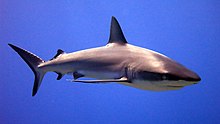
A | B | C | D | E | F | G | H | CH | I | J | K | L | M | N | O | P | Q | R | S | T | U | V | W | X | Y | Z | 0 | 1 | 2 | 3 | 4 | 5 | 6 | 7 | 8 | 9
| Sharks Temporal range: Possible records extend back to Early Permian
| |
|---|---|

| |
| A grey reef shark (Carcharhinus amblyrhynchos) | |
| Scientific classification | |
| Domain: | Eukaryota |
| Kingdom: | Animalia |
| Phylum: | Chordata |
| Class: | Chondrichthyes |
| Subclass: | Elasmobranchii |
| Infraclass: | Euselachii |
| Clade: | Neoselachii |
| Subdivision: | Selachimorpha Nelson, 1984 |
| Orders | |
| Synonyms | |
| |
Sharks are a group of elasmobranch fish characterized by a cartilaginous skeleton, five to seven gill slits on the sides of the head, and pectoral fins that are not fused to the head. Modern sharks are classified within the clade Selachimorpha (or Selachii) and are the sister group to the Batoidea (rays and kin). Some sources extend the term "shark" as an informal category including extinct members of Chondrichthyes (cartilaginous fish) with a shark-like morphology, such as hybodonts. Shark-like chondrichthyans such as Cladoselache and Doliodus first appeared in the Devonian Period (419–359 million years), though some fossilized chondrichthyan-like scales are as old as the Late Ordovician (458–444 million years ago).[1] The oldest confirmed modern sharks (selachimorphs) are known from the Early Jurassic, about 200 million years ago, though records of true sharks may extend back as far as the Permian.
Sharks range in size from the small dwarf lanternshark (Etmopterus perryi), a deep sea species that is only 17 centimetres (6.7 in) in length, to the whale shark (Rhincodon typus), the largest fish in the world, which reaches approximately 12 metres (40 ft) in length.[2] They are found in all seas and are common to depths up to 2,000 metres (6,600 ft). They generally do not live in freshwater, although there are a few known exceptions, such as the bull shark and the river shark, which can be found in both seawater and freshwater.[3] Sharks have a covering of dermal denticles that protects their skin from damage and parasites in addition to improving their fluid dynamics. They have numerous sets of replaceable teeth.[4]
Several species are apex predators, which are organisms that are at the top of their food chain. Select examples include the tiger shark, blue shark, great white shark, mako shark, thresher shark, and hammerhead shark.
Sharks are caught by humans for shark meat or shark fin soup. Many shark populations are threatened by human activities. Since 1970, shark populations have been reduced by 71%, mostly from overfishing.[5]
Etymology
Until the 16th century,[6] sharks were known to mariners as "sea dogs".[7] This is still evidential in several species termed "dogfish," or the porbeagle.
The etymology of the word shark is uncertain, the most likely etymology states that the original sense of the word was that of "predator, one who preys on others" from the Dutch schurk, meaning 'villain, scoundrel' (cf. card shark, loan shark, etc.), which was later applied to the fish due to its predatory behaviour.[8]
A now disproven[original research?] theory is that it derives from the Yucatec Maya word xook (pronounced [ʃoːk]), meaning 'shark'.[9] Evidence for this etymology came from the Oxford English Dictionary, which notes shark first came into use after Sir John Hawkins' sailors exhibited one in London in 1569 and posted "sharke" to refer to the large sharks of the Caribbean Sea. However, the Middle English Dictionary records an isolated occurrence of the word shark (referring to a sea fish) in a letter written by Thomas Beckington in 1442, which rules out a New World etymology.[10][original research?]
Evolutionary history
Fossil record
Zdroj:https://en.wikipedia.org?pojem=SharkText je dostupný za podmienok Creative Commons Attribution/Share-Alike License 3.0 Unported; prípadne za ďalších podmienok. Podrobnejšie informácie nájdete na stránke Podmienky použitia.
Antropológia
Aplikované vedy
Bibliometria
Dejiny vedy
Encyklopédie
Filozofia vedy
Forenzné vedy
Humanitné vedy
Knižničná veda
Kryogenika
Kryptológia
Kulturológia
Literárna veda
Medzidisciplinárne oblasti
Metódy kvantitatívnej analýzy
Metavedy
Metodika
Text je dostupný za podmienok Creative
Commons Attribution/Share-Alike License 3.0 Unported; prípadne za ďalších
podmienok.
Podrobnejšie informácie nájdete na stránke Podmienky
použitia.
www.astronomia.sk | www.biologia.sk | www.botanika.sk | www.dejiny.sk | www.economy.sk | www.elektrotechnika.sk | www.estetika.sk | www.farmakologia.sk | www.filozofia.sk | Fyzika | www.futurologia.sk | www.genetika.sk | www.chemia.sk | www.lingvistika.sk | www.politologia.sk | www.psychologia.sk | www.sexuologia.sk | www.sociologia.sk | www.veda.sk I www.zoologia.sk
